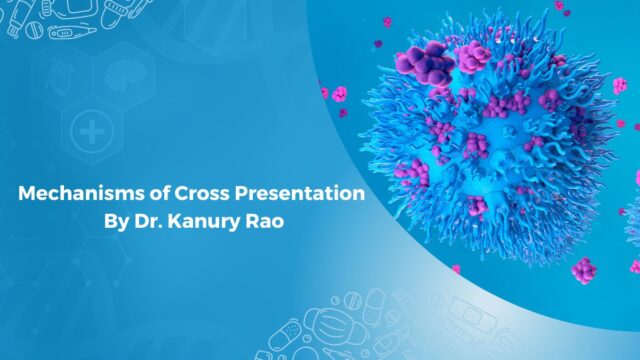The cross presentation is a primary mechanism of monitoring phagocytes and tissues to detect the existence of unknown antigens. The dendritic cells have the capability to process extra-cellular antigens. The other cells which are also associated with cross presentation are:
- Sinusoidal endothelial cells
- B lymphocytes
- Macrophages
The above cells are found to be cross presenting antigens in vitro and vivo.
What is Cross Presentation?
The exogenous antigens are generally present on the top of the dendritic cells by MHC II. The function of the cross presentation is to place these antigens by the MHC I. Despite the association of MHC I with infected endogenous antigens, the cross presentation has made it possible to utilize it without triggering any kind of infection.
Determinants of Cross Presentation
The factors that regulate the function of cross presentation:
- Activation of cross presentation of the dendritic cells.
- Environmental signs
- Uptake of Antigens
- Processing methods of the antigens
Role of Cross Presentation in Immunity
Cross presentation has been successful in acting as the immune shield against popular:
Viruses:
- Influenza Virus
- Herpesvirus
- Papillomavirus
Tumor:
- Leukemia
- Pancreas
- Melanoma
- Brain Tumor
Bacteria:
- Salmonella
- M. tuberculosis
- E.coli
- Listeria
Role of an expert
To make the immune system extra-responsive, you must always seek an expert’s aid. Dr. Kanury Rao is an eminent immunologist who in his research days has monitored the evolution of the diseases and the therapies.
Role of Cross Presentation in Immunity Tolerance
¹The procedure of cross presentation of the dendritic cells is impactful. In other words, it leaves a consequence of peripheral and central immunity tolerance. The dendritic cells that include the peripheral tissue are able of defending against cytotoxic T cells compatible of producing self peptides.
They produce antigens (tissue specific) in lymph nodes for regulation of the T cells. The scenario is different in the central tolerance. The location of dendritic cells is in the Thymus.
Medulla thymic epithelial cells initiate the antigens. However, the relationship between ìthe dendritic cells and the central tolerance is yet to be known. Moreover, it has been observed that these thymic dendritic cells play a complimentary to mTECs during selecting T cells negatively.
Dr. Kanury Rao has acquired a vast knowledge in this field with his 20 years of invaluable practice.
Significance of Cross Presentation in Surveilling Immunity
This procedure is the sole means to detect and react to the viral mutations. These infections refer to the mutations of the parenchymal cells. The dendritic cells are professional APCs are possess the ability of cross presenting the antigens.
Endocrytic mechanism like macropinocytocis or phagocytosis assists these cells to extract protein from the other cells. Hence, the 1 of the antigens involve two dissimilar procedures:
- The former mechanism involves the spilt of the antigens into peptides with the help of endesemol proteases.
- The latter process is associated with the transformation of phagosome into cytosol. Firstly, the proteasomes hydroloyzed the antigens into oligopeptides. The transporter involved with them transfer it to the phagosomes.
The nature of an antigens determines the pathway. Therefore, through either of this mechanism, it can participate in the vivo cross presentation. The end product of this presentation can be any of the following:
- Immunity
- Tolerance
The Role of Degraded Delayed Antigen
The last few years of observations have concluded that the stable intra-endosomal antigen regulates cross-presentation in complicated manners. Check out the below points for further explanation on it:
- It is believed that degradation of antigen at a faster rate can be the cause for destruction of a vast quantity of epitopes. As we know, DCs are mostly active in cross presenting cells, they can also produce various prevention mechanisms of rapid degradation of lysosomal antigens.
- The DCs produces lysosomal proteases in lower volumes. They also reflect endosome maturation of low velocity. The usage of stimuli like LPS with DCs will further decrease the entry of lysosomal proteases to phagosomes.
- The endocytosis receptors of the DCs particularly focus on endosomal compartments of non-degradative nature.
- An active alkaline reactions of the endosomes cause a hindrance of the activation lysosomal proteases from the pH front.
The most Complicated Mechanism of Cross Presentation
Post entry of the antigens into the endosomal compartments (non-degradative), they are processed. The proteasomal degradation of them are done during this process. This is the primary procedure of cross presenting the antigens. However, there is an ongoing argument in relation to the in-depth analysis of this intracellular transportation.
Conclusion
Hundreds of researches have been conducted till date to understand the mechanism of cross presentation. Several questions have also come up in the due process regarding this Molecular mechanisms. For example: How are the antigens transported into the cytosol? What mechanism is effective in vividly?, etc. Dr. Kanury Rao is a leading immunologist who is associated with the research and studies of peptides synthesis. He is also the designer of synthetic peptide vaccines.







